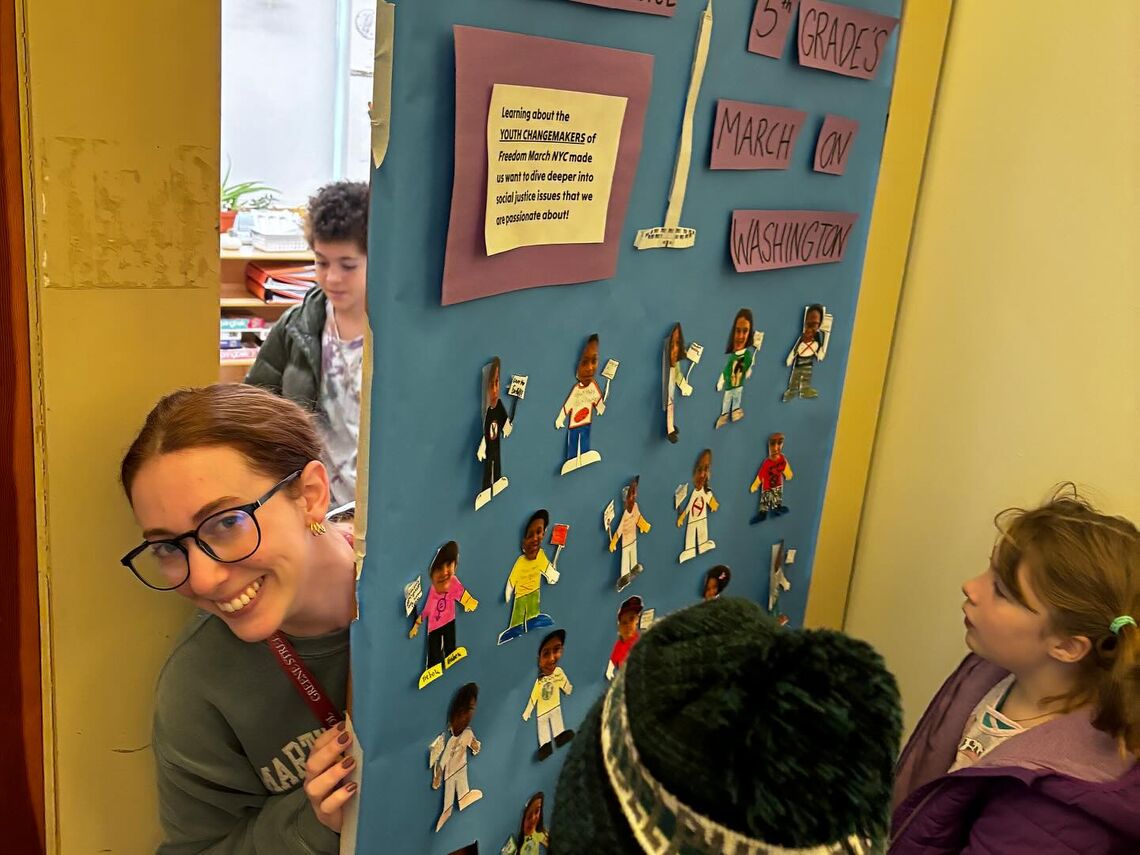- Home /
- Academic Journey /
- Middle School (5 to 8) /
- Social Studies
Navigate
5th grade Social Studies
-
 If you were dropped on Earth with nothing but the clothes you are wearing in a time before human civilization began, where would you want to be dropped? Fifth graders begin their year in social studies by using thematic maps to identify “The Best Place on Earth,” and then engage in research in order to make persuasive, multimedia presentations. Along with learning nonfiction reading skills, writing research papers, designing presentations and learning how to make group work successful, students also put themselves in the place of the earliest humans. The Best Place on Earth project launches a yearlong study of early river valley civilizations including Egypt, Mesopotamia, the Indus Valley, and China. Students learn about agriculture, architecture, religion, government, and language though a variety of hands-on projects. Study skills, nonfiction reading skills and five-paragraph essays are also emphasized in fifth grade social studies.
If you were dropped on Earth with nothing but the clothes you are wearing in a time before human civilization began, where would you want to be dropped? Fifth graders begin their year in social studies by using thematic maps to identify “The Best Place on Earth,” and then engage in research in order to make persuasive, multimedia presentations. Along with learning nonfiction reading skills, writing research papers, designing presentations and learning how to make group work successful, students also put themselves in the place of the earliest humans. The Best Place on Earth project launches a yearlong study of early river valley civilizations including Egypt, Mesopotamia, the Indus Valley, and China. Students learn about agriculture, architecture, religion, government, and language though a variety of hands-on projects. Study skills, nonfiction reading skills and five-paragraph essays are also emphasized in fifth grade social studies.6th Grade Social Studies
-

Building on fifth grade studies of ancient cultures, sixth grade social studies takes a thematic and global approach to studying the modern world, even as we move through the regions of the Caribbean, Latin America, Africa and Asia. Themes visited throughout the year include colonization, merging of cultures, protest, independence, peace-building, industrialization, and sustainability. Students consider potential problems and solutions faced by the modern world in the areas of food, shelter, resources, and population. Social justice issues are woven throughout the curriculum, with focus on racial, religious, and gender equality. Students learn a great deal of world geography, and they come to see the many connections between places in our modern world.Critical thinking and collaborative problem-solving skills are frequently engaged in sixth grade social studies. Many lesson take an inquiry-based approach, with students posing hypotheses and using resources (such as google earth, atlases, websites, books) to test out their own ideas. Experiential projects - such as simulations recreating historical events - allow students to plug themselves into situations and arrive at deeper understanding of the issues at stake. Regular work develops students’ skills in the areas of annotating text, categorizing information, paraphrasing, interpreting maps and visual data, making inferences, and evaluating effects. In a culminating project, students design their own “future cultures,” predicting problems and solutions in one part of the world several hundred years in the future.7th Grade Social Studies
The curriculum in 7th grade Social Studies begins the two-year journey through American history. The class will focus on the collision of conflicting agendas that have marked the development of the United States and the North American continent. From Pre-Columbian contact, the class will trace the growth of the nation through the study of key episodes like exploration, colonization, revolution and the development of government. The year culminates in a unit that highlights the growth opportunities and conflicts that led the United States to the brink of Civil War.
The students will examine the wide variety of ways in which history can be recorded, and learn to differentiate between fact and opinion. In addition to the textbook, they use primary sources, film, music, photographs, and newspapers to bring past moments to life and enable students to take historical perspective. The course teaches the skills of note taking, outlining, reading comprehension and studying throughout the year, and students engage in the research/writing process.-

8th Grade Social Studies
The odyssey through American history continues in 8th grade, beginning with a unit on the Civil War and Reconstruction. Using a chronological approach to curriculum material, American history blends with world history as study enters the 20th century, due to the emergence of the United States on the world stage. Units cover the two world wars, separated by study of the troubled times between the wars. Later in the year, the class engages with the Cold War, the civil rights movement, and modern world conflicts. Throughout the year, students will connect current events with historical episodes.
Source documentation of the material includes increasing amounts of photography, audio, and video, and the class takes ample opportunity to use these sources to increase understanding. There is considerable focus on helping students interpret these sources and manage the vast array of resources available to them. Students are expected to graduate with a well-developed set of traditional and digital research skills, and an understanding of the strategies they need to employ to meet success in high school.
-
-

